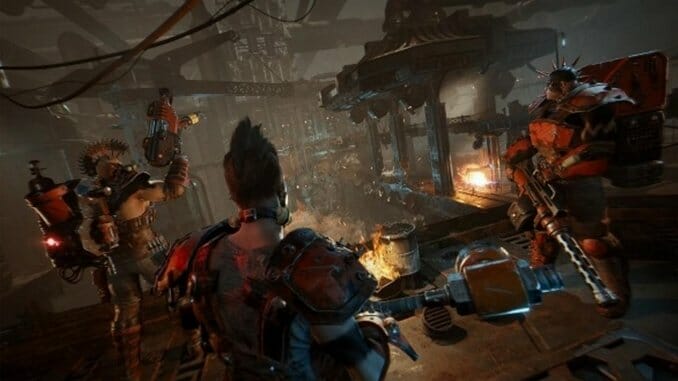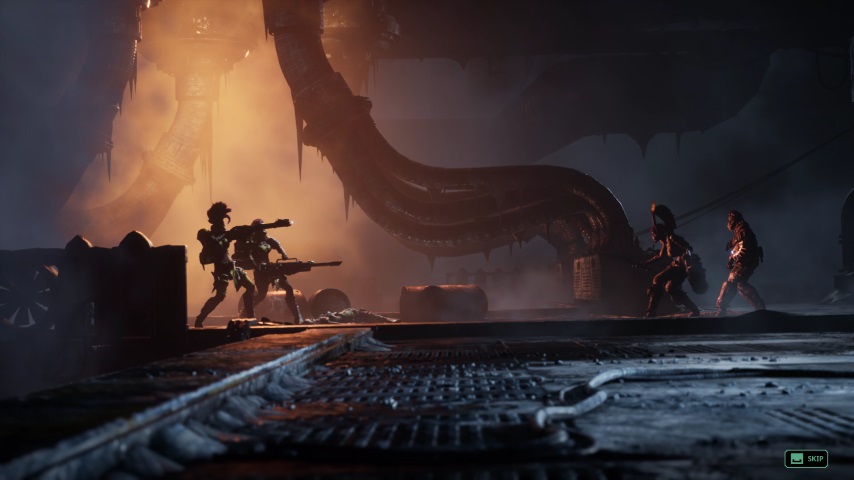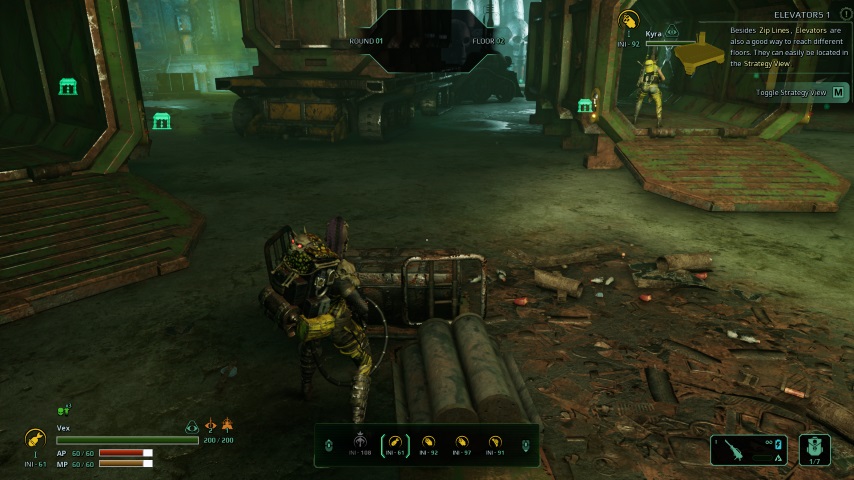If Only Necromunda: Underhive Wars Was as Cool as It Looks and Sounds
Games Reviews Necromunda: Underhive Wars
Tessera runs shit here. You know this because when you’re introduced to her, she’s reclining patrician-like, flanked by bored, heavily armed hot girls with bad ink and piercings and shaved heads. She’s on a dais (which is probably just some cobbled together ductwork and shipping crates) covered in yards of “discount bin at Jo-Ann” leopard print fabric. She’s the picture of a late ‘70s Bromley girl tossed into a nightmare of sewer pipes and concrete floors. She fucking rules.
In another time, another genre, another game she would be an amazonian goddess, a warrior priestess of destruction and power, an icy-hearted matriarch. But here, in the fetid dark of the Underhive, more sewer and boiler room than home, she’s our boss. There are others like her, some above her, but she’s my head bitch. And right now she’s got a lead on some sick tech. Archeotech. Real old. The good stuff. That balance of power shifting mcguffin shit.
So, we’re going to have to kill a lot of people for her. That’s her plan. It’s the only plan. Because in the Underhive, death and killing is just Monday morning. Also Tuesday through Sunday. And we do what the HBIC says. It’s what we have.
Well, that and lots and lots of really cheap leopard print fabric. And purple hair dye.
We got our priorities, okay?

God, if only the game was actually this cool.
Unfortunately, Rogue Factor’s Necromunda: Underhive Wars, the latest adaptation of a Games Workshop tabletop wargame set in the Warhammer universe, has priorities too.
(Did that sentence exhaust you? Because it exhausted me—don’t worry, it’s intentional.)
Chief among these priorities is that you really have to play the single-player story campaign. They mean it. It’s fully voiced (even if it feels like a lot of the voice actors are doing double and triple duty at times), and it has beautiful (if anything in the Underhive can claim that adjective) cutscenes—kinetic and explosive, dripping with the kind of ludicrous edgelord cool that only Warhammer 40,000 can possibly play off. It makes you start off as an extremely punk rock all-girl death squad.
They even recruited veteran Warhammer writer Andy Chambers to develop the story. It’s grimdark and full of Warhammer 40k stuff. There’s betrayals, heroic faults, faction shifts, everyone is angry and a cartoonish British punk rocker except for Kyra (a quasi-POV character who sounds like she walked in from an anime dubbing and no one told her to go home). It’s all very long.
Also the story only happens in cutscenes. The cutscenes are great. It’s getting from one to the other that sucks.
Necromunda began its life in 1995 as a tabletop skirmish game offshoot of the main Warhammer 40,000 wargame. Grognards don’t read this: it’s basically the same thing, but smaller. Gangs instead of armies. Yards instead of kilometers. Lower tech, grittier. The point is you’d get your painted up miniatures and put them on some terrain covered in tarted-up foam core and plastic with some Official scenery and some salvaged model railroad stuff. You’d take turns rolling dice and whipping out blast radius stencils and measuring tape to figure out line of sight and range. You’d kill some of your friends’ dudes, they’d kill some of yours.
Because Necromunda was smaller in scope, it allowed for some management and RPG-like mechanics. There was squad upkeep. Your gang members could grow in strength and ability between battles. If they lived.
It was very slow, and even at the small scale you needed a big table.
Nobody has time for that shit.
Lavishly painting figures and making bad scenery was a lot of fun though.
Underhive Wars is an attempt at translating that experience. Here’s the thing, though: I can’t tell you if it’s a faithful experience mechanically. It’s been nearly 20 years since I even tried to play Necromunda (one summer with my stepfather who really hated that I colonized the dining room table to lay out dozens of plastic minis to paint, and never dry because it was summer and the air was 87% saltwater).
In theory, adapting a tabletop skirmish game into a videogame should be easy. All the math is laid out, and the rules and logic are prepped for you already. Everyone knows what it should play like. One might think they could just plug that in, slap some art on it, and tweak it until it feels good. And in theory, because all of the math and fiddly bits are being handled by the computer, it will play faster.
Well, it doesn’t work that way. Even if we say that’s what we want, delivering on the experience of standing around a table with friends isn’t sitting in front of your computer or Xbox. Adaptation isn’t xeroxing. It’s not insert Tab A into Slot B.
It’s interpretation. What does this shape look like when it’s folded up? Interpretation allows for vast divergences. Sometimes it can lead to grand strokes of brilliance. Sometimes you get Rogue Faction’s last attempt at adapting a Warhammer property for PC and console. Sometimes you get Mordheim: City of the Damned.
I actually liked Mordheim, the videogame. I never played Mordheim, the tabletop game. But hey (and again, grognards don’t read this), no one wants a direct translation of the tabletop experience. I think it might be a really bad idea.
And Necromunda takes a literalist approach to the worst part—waiting for your friends to JUST MAKE A FUCKING MOVE ALREADY! JESUS, JARED IT’S BEEN 20 MINUTES! I’M GOING TO PEE, EVERYONE WATCH SO HE DOESN’T CHEAT!
You will wait endlessly as the AI or other players move every other turn. “Spectating” is what the game calls it, but it’s closer to being stuck in traffic on the NJ Turnpike during Labor Day weekend. The AI is inscrutable, slow, and dim.
I watched one Goliath (a rival gang, favoring raw strength and the color red) brawler walk halfway across the map. Turn around. Walk all the way back, walk half the distance back again, and walk to an elevator call button. There he ran through a sequence of buff, kneel, stand, kneel, stand, kneel. Then stood motionless, seeming to look at the elevator call button in dismay, because he’d run out of action points. He stood motionless for another minute. Then finally ended his turn with a grunt.
I’d like to say this was an edge case, but it was not. Other NPCs spent five to 10 minutes trying to line up shots before giving up. Some would get hung up running into terrain for half an hour in one case (I had to restart the game, which sucked because I was winning that round).

At least in Underhive Wars, the AI theoretically can’t cheat. But it sure feels like they do sometimes, when they’re not actually functioning like the Keystone Kops. The AI is brutal.
The three gang members across the room? The ones with their backs turned? I mean the ones completely focused on another part of the arena? That you’re yards and yards away from? Try skirting past them to set up your own shot. Boom. You’re dead before you’ve spent half your movement points, because they spotted you, and fired off three lasrifle blasts that ripped straight through your head.
Overwatch is a godly sphere of long-range death in this game.
You play the entire game in a third-person, over-the-shoulder camera always. So you always get a front row seat to the inevitable evisceration, whether it’s your turn or theirs.
Of course, you don’t only get to watch, exhaustingly, as the enemies make their moves. You can at any time check the tactical map that tells you where everyone is, where more baddies will spawn, and all the major points of interest.
What doesn’t the game tell you? Where you set that trap down two turns ago, so when it completely blends in with the muddy, cluttered textures of the floor (it will), you’ll walk right over it.
“Hoisted,” as the Idle Thumbs fans say wistfully longing for the podcast’s return.
Each member of your squad gets abilities based on their class, weapons, and range. Some get traps, or sabotage skills to change the environment. Some get heavy weapons skills, more attacks, squad-based buffs, etc. Nothing groundbreaking, and more often than not you’ll be spending points on basic attacks. Or overwatch (because you spent an hour trying to figure out if you’re in range of anything, and fuck it just end the turn). You spend the aforementioned action points to use them, and you spend the aforementioned movement points to move around. The UI ticks off in the bottom as you do this.
You move, you spend points, you get a kill, sometimes you set up kills. Sometimes you heal or buff. In the story mode, you get assigned a gang, and you control five members each combat mission. Each turn you go, then the enemy, then you. When everyone’s moved, the turn is over. Repeat until you’re dead, you’re out of turns, or you succeed.
Missions vary, not much, but some. There are “gather X of Y” missions. There are “kill everyone” missions. Sometimes you get “kill everyone and then also do something before time runs out” missions. Occasionally someone MUST survive. Occasionally there are bonus objectives that reward more money and experience if you complete them. Nothing earth shattering here. Rogue Factor touts verticality in this game, and there are lots of vertical spaces to the combat zones, but it’s not nearly as interesting as it sounds. Lining up shots, determining where you can move in these tiered environments could be cool, but it always feels haphazard.
Fundamentally this is a very simple squad-based turn-based strategy game. It got a paint job in the form of 40k aesthetics, but you’ve played this game. You’ve probably played more successful versions of this game that just LOOK different. Or ones that are variations.
It’s a Battletech meets XCOM that borrows a pink mohawk Shadowrun sheen (that’s for you semi-grognards) sort of deal. Instead of mechs or a squad of international anti-alien soldiers you’re burly ladies or big boys. Okay, there are some middle-bigness and svelte gang members too. But it’s nice that you can make a squad of thickies.

Of course, there are catches.
You’ll find them when you dive into the core gameplay mode of starting and managing your own gang in a presumably endless cycle of violence and acquisition. You can play against the AI or human opponents. You can name your gang, name your squaddies. You can customize what they are and how they look—there’s the first catch. Body types are tied to stats. Which sucks. In a numbers game, numbers matter. Body type matters.
Want to make a fat sniper? Well that’s just not efficient. Especially when you’re going up against players who absolutely are min-maxing. The game doesn’t forbid it, but it’s numerically discouraged.
Also, it’s just fucking weird to tie fatness to Toughness and Resilience. I’m fat, and I have a complete breakdown if my phone rings. I burned my fingers pulling ramen out of the microwave the other day and I’m still upset about it. One time my knee decided it wanted to go in a direction it was never intended to. This copy is like a week and a half later than I said I’d deliver it—because of STRESS. So much for resilience.
But, I never miss throwing a kleenex in the trash can from across the room. So where’s my bonus to accuracy? I can jump up out of the bed and be at the door in seconds if the buzzer rings. Where’s my speed and reaction bonus?
Can we just stop with making these fatphobic impositions and moral statements about bodies? Because that’s what this is, even unintentionally.
Fat people are slow but tough. Thin people are agile and alert. Are you kidding me?
It’s shitty. Quit it.
Second catch? If you want to change your squaddies hair styles, you must complete the entire story mode. No exceptions. It’s a truly baffling decision to lock hairstyles (and gas masks???) behind a story campaign. Sure, it’s probably tolerable, but it’s just weird. A massive, multi-hour roadblock. Did I mention the story mode is long, not that compelling, and probably not why you picked up a game that’s selling itself on MAKE YOUR OWN GANG, CUSTOMIZE THEM, AND RIP SHIT UP?
I wasn’t hype to play a story mode. I like narrative in games, but I can’t even impact the narrative in small ways here, and it’s just not as fulfilling as reading a finely crafted short story. Or an anthology of short stories. I came here to put my friends in a game and wreck dudes with their digital hellscape punk rock avatars.
Third catch (no, were not out of character customization yet): There are multiple skin tones. But the dark skin tone offerings are weird. I went through a lot of permutations and this is the best Black character I could come up with.

There’s not even an option to be as brown as me, and I’m brown but I’m not THAT brown. You certainly can’t make a Black character. The best is you end up at this weird sickly pale corpse blue-purple tinge. You got radiant colored mohawks and snazzy gang colors, but no decent brown skin?
Look. It’s 2020, y’all.
There’s no excuse for not having decent Black hair and dark skin options that don’t look like zombie cosplay. Come on. If you put character customization in your game, and you DON’T account for the hair and skin of People of Color, your game is not ready. You probably aren’t ready.
And when you finally muddle your way through all the undercooked UI, and have a squad that is almost but maybe not really what you want? You’re basically left with the same undercooked game. Now with shopping and gang management. Both equally undercooked and buried in menus that weren’t designed for elegant or straightforward use.
It sucks.
I really had hope for this game. I was genuinely excited, pestering my editor well in advance to review it. Even as unrefined as Mordheim was, with its departure (I’m told) from the board game, I enjoyed being the Rat King to a resource grabbing, Teutonic fantasy with dudes named things like “Legeater Gnaw.”
If Rogue Factor had offered that much, and didn’t get weird and shitty with the customization, this would have been a delightful 7/10. Something that would stick around and I’d tweet about to my friends.
Because that’s why games like Battletech and XCOM are precious to me.
I love sending my friends off to a bloodbath. I’ve learned to love this kind of strategy game for this reason alone—it’s unbelievably fun to field a squad made up of, well, your own fuckin’ squad. It’s the natural outgrowth of tabletop roleplaying games. Sitting around with friends, building your characters, your squad, and becoming a wrecking ball until you all bite it. Doesn’t matter if it’s “rocks fall, everyone dies,” or pop-pop in the back. There’s real joy in getting merked with your friends.
Now we have jobs and COVID and you just can’t do that shit anymore. No one has the time, even with a service like Roll20 or NEW TTRPG thing. Schedules are tough. Psychic bandwidth is scarce. But the nice thing about squad-based tactics, or even Wizardry-like dungeon crawlers? You can do them pretty much whenever you have time with no coordination—and still bring your friends along to wreck shit and die spectacularly.
That’s the promise of games like XCOM.
It’s watching Danielle Riendeau and Maddy Myers, buying time for everyone to evac safely as wave after wave of Murder Robots keep approaching, taking them down one after another until they can escape themselves. Or that time Alex Navarro died, and Maddy carried his body home, because no one gets left behind.
Making avatars for your friends and having them going apeshit kicks ass. It’s the only storytelling component these games need—making up your own, and sharing them. That’s really the whole draw of games like these.
And Necromunda: Underhive Wars fumbles so hard with what felt like a laser-guided missile designed specifically to blow my shit up and become my Game of the Year (even if it was rough).
But, in the end, I was super let down. Even with all the broken, tedious bits—I still enjoyed playing Mordheim. But I didn’t want to play Necromunda anymore. If I’m honest, I wanted my hard drive space back, and it’s not that big of an install.
Maybe in a few months there’ll be patches, course corrections, and I’ll get an update and try it again. I came to Mordheim late and I have no idea what the base game was like. XCOM 2 needed War of the Chosen to really become the game I wanted to play. Maybe Rogue Factor just needs time to make Necromunda become the badass squad-skirmish game that I wanted it to be.
Necromunda: Underhive Wars was developed by Rogue Factor and published by Focus Home Entertainment. Our review is based on the PC version. It is also available for PlayStation 4 and Xbox One.
Dia Lacina is a queer indigenous writer and photographer. She tweets too much at @dialacina.